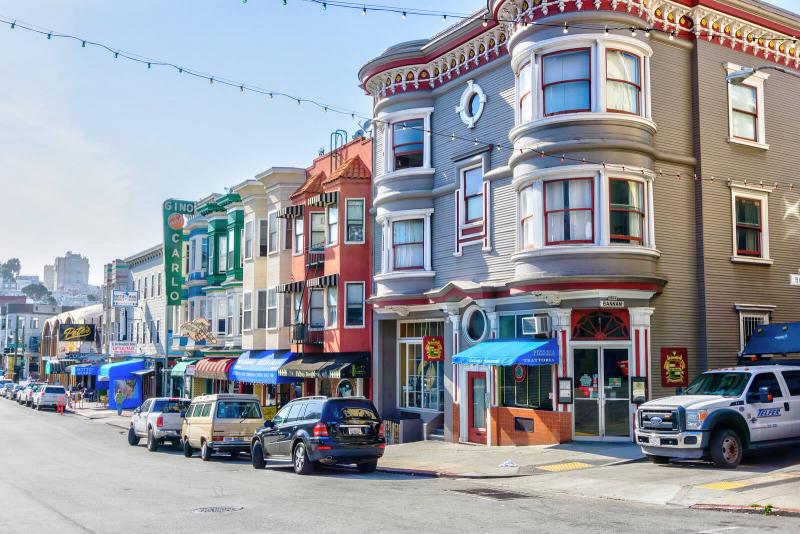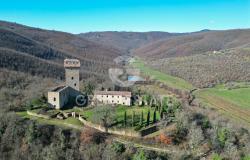Much like other Little Italys in the U.S., San Francisco’s North Beach saw a decline of its Italian population after the 1950s. Today, what points to the neighborhood’s Italian heritage is mostly the number of Italian restaurants and cafés, the signs in Italian, the green-white-red colors.
Gentrification, a decline in immigration from Italy, and the expansion of neighboring Chinatown have caused a major demographic shift in the neighborhood, which now sees a mix of Chinese, other ethnic groups, young professionals, and few Italian American residents.
North Beach – so called because the area was an actual beach, filled in with landfill in the late 19th century - was once the epicenter of Italian life in San Francisco. It stands in the northeast of San Francisco adjacent to Chinatown, the Financial District, and Russian Hill. Columbus Avenue, one of the major streets of San Francisco that runs diagonally through North Beach, wasn’t always called that: until 1909, it was known as Montgomery St. When the city renamed a number of streets, Columbus was chosen due to the area’s Italian American population.
Italian immigrants gave the neighborhood its Italian character following the reconstruction after the 1906 earthquake.
Italians were major players in San Francisco’s economy during the 20th century. One of the most prominent figures in San Francisco’s and the nation’s history is Amadeo P. Giannini, the founder of what is today the Bank of America. Born in San José, CA, the son of Italian immigrants from Liguria, Giannini was the first to loan money to immigrants and low-income families, rather than just the upper classes, thus helping many achieve their ‘American dream’.

[Amadeo Giannini at his office in San Francisco.]
Bank of America began as the Bank of Italy in 1904, housed in a converted saloon, serving people other banks would not serve. When the 1906 earthquake struck, Giannini was able to salvage the vault’s money and one of the very few bankers to continue making loans, reportedly laying planks over two barrels to continue doing business, thus helping finance the reconstruction of the city. “San Francisco will rise from the ashes,” he said.
In 1908, the bank moved into the eight-story Beaux-Arts building at 550 Montgomery St. — now landmarked as the Bank of Italy Building. Currently, Bank of America holds one-tenth of all the deposits in the United States.
A major figure associated with North Beach is baseball legend Joe DiMaggio. Born in Martinez, he grew up in the neighborhood and married his first wife, Dorothy Arnold, at Saints Peter and Paul Church, known as the Italian Cathedral of the West. Completed in 1924, located opposite Washington Square Park, it’s been the beloved church of the Italian American community of San Francisco since its consecration.

[The spires of Saints Peter and Paul church in North Beach.]
Because it’s a Catholic church, when DiMaggio re-married (with Marilyn Monroe), he could not have his wedding officiated in the church, so he had a civil ceremony at City Hall instead and then had their photographs taken on the steps of the church. The church keeps a photos of DiMaggio’s first wedding – but none of his wedding to Monroe. DiMaggio’s small, private funeral was held in the church in 1999.
Saints Peter and Paul Church has been featured in many films. Inside is a Carrara marble altar and a replica of Michelangelo’s Pietà.
North Beach also gave the country one of its most influential literary subcultures, the Beat Generation. Many of the movement’s most famous writers and personalities, including Jack Kerouac, Allen Ginsberg, Neal Cassady and Gregory Corso, lived in the neighborhood and met in its cafés. Lawrence Ferlinghetti founded the City Lights bookstore, which is still open today at the corner of Broadway and Columbus, and a pilgrimage destination for all fans of Beat culture.

[Beat generation writers including Lawrence Ferlinghetti, left, at Caffè Trieste in North Beach.]
And how not to mention the Ghirardelli Chocolate Company, founded by and named after Italian chocolatier Domenico Ghirardelli, who was born in Rapallo (Liguria), and moved to California after working in South America. Ghirardelli is the third-oldest chocolate company in the U.S. and Ghirardelli Square, where many of the Ghirardelli buildings were constructed, was declared an official city landmark in 1965 and is a major tourist attraction today. It’s in the Fisherman’s Wharf area, near North Beach.
San Francisco has had three Italian American mayors, and many other Italian politicians. Italians had prominent positions in City Hall, the Police Department and the Fire Department. Francis Ford Coppola wrote much of the screenplay for The Godfather while sitting in North Beach's Caffè Trieste (also a hangout for Beat writers), which was opened in 1956 by Giovanni Giotta. Giotta had emigrated in 1951 to the U.S. from the small fishing town of Rovigno D'Istria, now part of Croatia. Missing the espresso houses of Trieste, Giotta opened his own café, said to be the first espresso house on the West Coast. Caffè Trieste is a now a chain of four coffeehouses.
So while it’s correct to say that San Francisco’s Little Italy retains little of authentic Italian today, remnants of the neighborhood's Italian history and heritage are still there if you know where to look.













